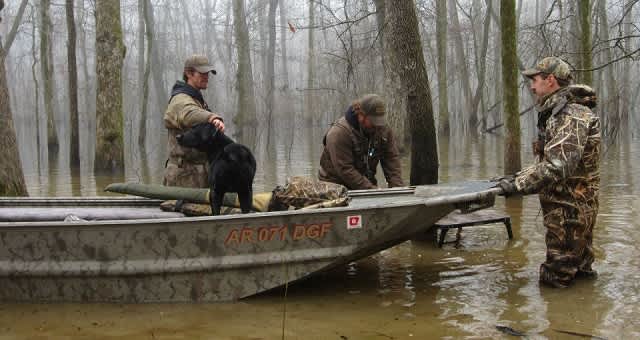America’s Hunter and Angler Numbers on the Rise–along with Their Economic Power
Andy and Tami McDaniels 02.06.13

The Congressional Sportsmen’s Foundation (CSF) recently produced their 2013 Sportsmen’s Economic Impact Report (pdf) on the number of hunters and anglers in the United Sates and the tremendous economic impact they have on our nation’s economy. The data for the report was compiled from the U.S. Fish and Wildlife Service’s National Survey of Fishing, Hunting and Wildlife Associated Recreation and the results were astounding. The Fish and Wildlife Service’s report is put together every five years, and additional economic figures for the CSF document were compiled by Southwick Associates with funding from the National Shooting Sports Foundation and the American Sportfishing Association.
The report’s numbers are encouraging for hunters. In 2011, 37.4 million Americans over the age of 16 spent time afield hunting or on America’s waters fishing. This is equivalent to the entire population of the state of California. The year also saw an increase in the number of hunters and anglers for the first time in recent history.
Roughly 13.7 million people over the age of 16 hunted in the United States in 2011. If you were to add those under the age of 16, another 1.8 million, the number increases to 15.5 million. Before adding the youth hunters to the overall numbers, that is an increase of 9% overall since 2006. Hunters across America spent $38.3 billion in 2011, that’s more than the revenues for Comcast in the same year.
Some other hunting highlights include:
- Trip-related expenses paid by hunters in mainly rural areas came to $10.4 billion, which is more than the total movie box office gross in 2011.
- Hunters spent $6 billion on items like guns, ammunition, and archery equipment–the same amount spent on all bicycle sales in the U.S. in 2011.
- The number of America’s hunters over the age of 6, 15.5 million, could fill every NFL stadium, NBA arena, MLB ballpark, NHL rink, and NASCAR track in the country more than twice.
- Hunters’ contribution to the conservation of wildlife habitat in 2011 totaled $8 billion to lease, own, and cultivate lands for hunting purposes.
 Angling is on the rise too, according to the report. In 2011, 33.1 million Americans over the age of 15 fished, if you add in the younger anglers from the ages of 6 to 15, another 8.5 million, the total grows to 41.6 million people. The over-15 number shows an increase of 11% since the last survey was compiled just five years ago. Fishing contributed $61.7 billion to the United States economy in 2011.
Angling is on the rise too, according to the report. In 2011, 33.1 million Americans over the age of 15 fished, if you add in the younger anglers from the ages of 6 to 15, another 8.5 million, the total grows to 41.6 million people. The over-15 number shows an increase of 11% since the last survey was compiled just five years ago. Fishing contributed $61.7 billion to the United States economy in 2011.
More notable fishing details were laid out as well, including:
- In 2011, America’s anglers spent $1.5 billion on bait, $142 million on tackle boxes, $2.37 billion on rods and reels, $593 million on lines and leaders, $628 million on hooks and sinkers, and $1.17 billion on artificial lures.
- The 2011 trip-related expenditures of $21.8 billion spent by anglers equates to more than the combined revenues for all major professional sports leagues–the MLB, NHL, NBA, and the NFL–for the same year.
- America’s anglers support 828,133 jobs across the United States. This is considerably more than 761,000 employed by McDonald’s nationally.
- America’s fishermen and women paid $8.2 billion dollars in federal taxes in 2011, this would pay the salaries of 410,000 active duty privates in the U.S. Army.
When you add these numbers up, hunters and anglers contributed $90 billion to the U.S. economy in a period of one of the greatest economic depressions in American history. That equates to around $2,407 spent per hunter and angler, and the total is more than the global sales of Apple’s iPhone and iPad.
Benefits from this spending were felt in rural communities where hunters and anglers hunt and fish, and in companies within cities across the nation that produce the equipment that they buy to pursue their sport. Hunters and anglers have always been among the largest contributors to conservation and 2011 was no exception. In 2011, sportsmen and women contributed more than $3 billion towards conservation, including the purchase of licenses, stamps, excise taxes, motorboat fuel, and contributions to conservation organizations.
The demographic of America’s hunters and fishermen is varied and different as the nation itself. Hunters and anglers come from rural and urban settings from every socio-economic level and every state in the union. This report shows that undeniably, hunting and fishing are huge and important parts of our economy and that America’s sportsmen and sportswomen have one important thing in common–a great passion for America’s wild places and the wildlife that inhabits those places.

